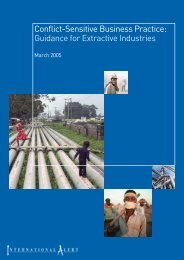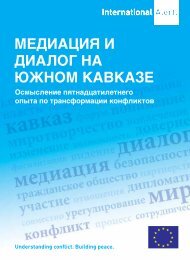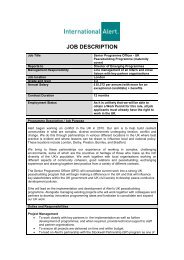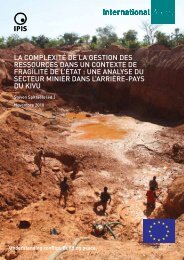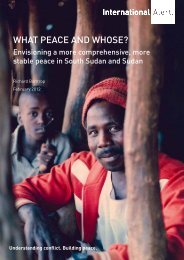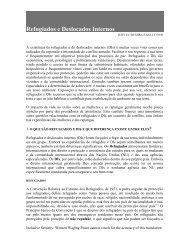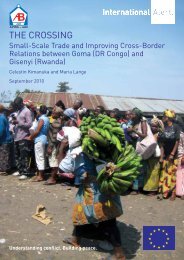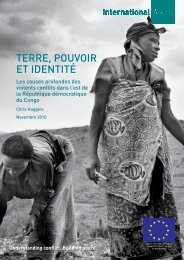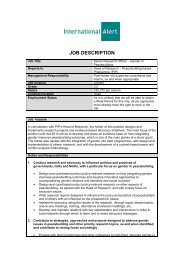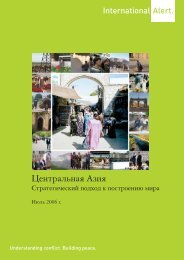The complexiTy of resource governance in a conTexT of sTaTe ... - Ipis
The complexiTy of resource governance in a conTexT of sTaTe ... - Ipis
The complexiTy of resource governance in a conTexT of sTaTe ... - Ipis
You also want an ePaper? Increase the reach of your titles
YUMPU automatically turns print PDFs into web optimized ePapers that Google loves.
<strong>The</strong> complexity <strong>of</strong> <strong>resource</strong> <strong>governance</strong> <strong>in</strong> a context <strong>of</strong> state fragility: An analysis <strong>of</strong> the m<strong>in</strong><strong>in</strong>g sector <strong>in</strong> the Kivu h<strong>in</strong>terlands<br />
9<br />
the Kivu prov<strong>in</strong>ces, but the prov<strong>in</strong>cial authorities have managed to transform it <strong>in</strong>to a system <strong>of</strong><br />
their own mak<strong>in</strong>g.<br />
In Maniema territory, “artisanal m<strong>in</strong>ers” have taken over what was previously <strong>in</strong>dustrial production.<br />
Hav<strong>in</strong>g failed to restart <strong>in</strong>dustrial production, several m<strong>in</strong><strong>in</strong>g companies turned to commercialis<strong>in</strong>g<br />
the ores extracted by artisans operat<strong>in</strong>g on their own concessions. Maniema benefits little from its<br />
m<strong>in</strong>eral wealth. <strong>The</strong> neglected transport <strong>in</strong>frastructure means that most m<strong>in</strong>eral production is flown<br />
out from airstrips across the prov<strong>in</strong>ce to comptoirs <strong>in</strong> Goma and Bukavu <strong>in</strong> the Kivu prov<strong>in</strong>ces.<br />
Gold m<strong>in</strong><strong>in</strong>g <strong>in</strong> Bafwasende and Mambasa territories has largely escaped the scrut<strong>in</strong>y <strong>of</strong> the<br />
prov<strong>in</strong>cial authorities and state m<strong>in</strong><strong>in</strong>g agencies, and most <strong>of</strong> its product is sold <strong>in</strong> North Kivu.<br />
This is unlikely to change soon s<strong>in</strong>ce many m<strong>in</strong><strong>in</strong>g sites <strong>in</strong> Bafwasende are <strong>in</strong>formally controlled<br />
by armed groups or soldiers with<strong>in</strong> the FARDC. In neighbour<strong>in</strong>g Mambasa territory, a number <strong>of</strong><br />
private companies are runn<strong>in</strong>g semi-<strong>in</strong>dustrial operations on the Ituri River without apparently<br />
declar<strong>in</strong>g any production or export figures. F<strong>in</strong>ally, the prov<strong>in</strong>cial system for supervis<strong>in</strong>g m<strong>in</strong><strong>in</strong>g<br />
sites, which pre-dates the national M<strong>in</strong><strong>in</strong>g Code <strong>of</strong> 2002, has narrowed the space for state<br />
<strong>in</strong>tervention even further.<br />
Methodology and the research process<br />
<strong>The</strong> follow<strong>in</strong>g three chapters are based on documentation from local sources, <strong>in</strong>terviews with<br />
key stakeholders, visits to m<strong>in</strong>e sites <strong>in</strong> June and July 2010, and focus group discussions. <strong>The</strong><br />
stakeholders consulted were traders, local authorities, <strong>in</strong>ternational observers, local nongovernmental<br />
organisations (NGOs) and civil servants from the many DRC state agencies<br />
responsible for m<strong>in</strong><strong>in</strong>g, which provided much <strong>of</strong> the documentation.<br />
M<strong>in</strong>e-site visits were largely made by local partners engaged by the authors. Teams <strong>of</strong> local<br />
researchers (two per chapter) collected fresh data by visit<strong>in</strong>g m<strong>in</strong><strong>in</strong>g locations with GPS devices<br />
and questionnaires. Personnel from local universities and NGOs coord<strong>in</strong>ated the local research.<br />
Each had prior experience <strong>in</strong> m<strong>in</strong><strong>in</strong>g research (four out <strong>of</strong> six cases) or had conducted field work<br />
on other topics with GPS devices (two out <strong>of</strong> six). In most cases the teams engaged with <strong>of</strong>ficials<br />
from the state m<strong>in</strong><strong>in</strong>g agencies.<br />
Several approaches were used to evaluate the output <strong>of</strong> local researchers. After a prelim<strong>in</strong>ary set<br />
<strong>of</strong> results was delivered, one <strong>of</strong> the authors would pay a visit to follow up and work out solutions<br />
to the problems encountered. <strong>The</strong> track-logs <strong>of</strong> the GPS devices were checked if there was any<br />
doubt about the teams’ movements. Thirdly, data was cross-referenced aga<strong>in</strong>st exist<strong>in</strong>g maps<br />
and data already <strong>in</strong> the authors’ possession, or gathered dur<strong>in</strong>g their field research. In general,<br />
and tak<strong>in</strong>g <strong>in</strong>to account the short time-frame and the magnitude <strong>of</strong> the task, the research teams<br />
performed well and produced orig<strong>in</strong>al data. Naturally, the data rema<strong>in</strong>s <strong>in</strong>complete and subject<br />
to change s<strong>in</strong>ce the m<strong>in</strong><strong>in</strong>g sector <strong>in</strong> eastern DRC is <strong>in</strong> a permanent state <strong>of</strong> flux.<br />
Each chapter was written by two authors from different backgrounds, who travelled the region<br />
together and peer-reviewed one another’s drafts. <strong>The</strong> comb<strong>in</strong>ed chapters were edited by the<br />
International Peace Information Service (IPIS) and the f<strong>in</strong>al text reviewed by two <strong>in</strong>dependent<br />
experts: one a well-known academic; the other a former head <strong>of</strong> the UN Group <strong>of</strong> Experts. <strong>The</strong><br />
majority <strong>of</strong> research work, <strong>in</strong>clud<strong>in</strong>g field visits, was executed from June–August 2010.<br />
As an <strong>in</strong>tegral part <strong>of</strong> the study, IPIS has published three detailed maps onl<strong>in</strong>e at:<br />
www.ipisresearch.be/maps/h<strong>in</strong>terland/Katanga/web/<strong>in</strong>dex.html<br />
www.ipisresearch.be/maps/h<strong>in</strong>terland/Orientale/web/<strong>in</strong>dex.html<br />
www.ipisresearch.be/maps/h<strong>in</strong>terland/Maniema/web/<strong>in</strong>dex.html





